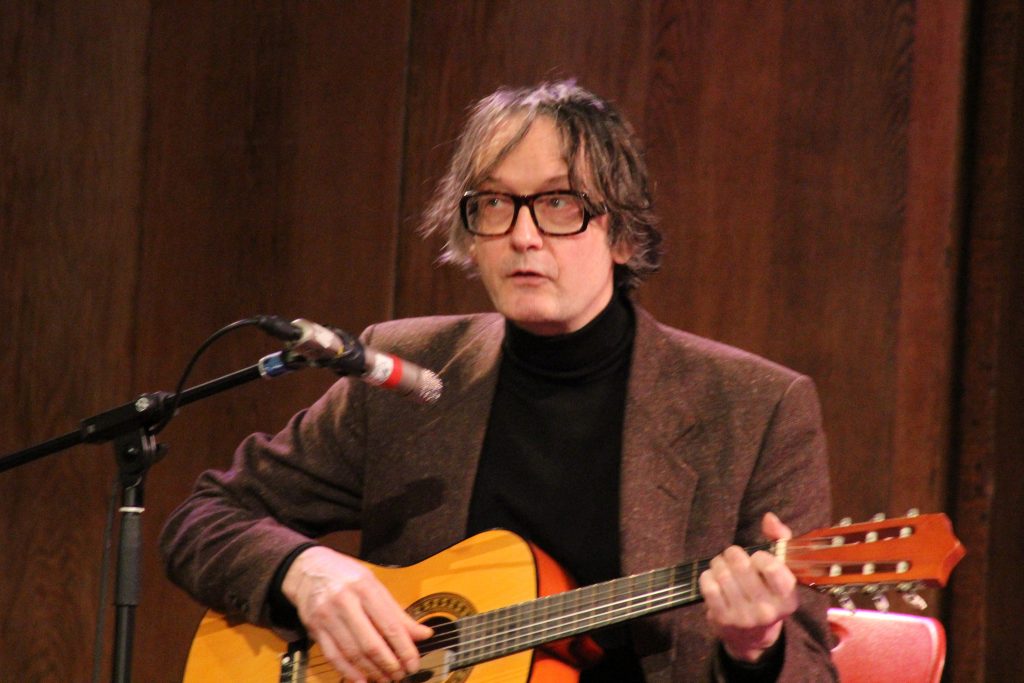WARNING: liveblogged – left in first person
This is about the Extraordinary
Artists are storytellers, they tell us different versions of the story about what it means to be a human being. Lots of people want to be an artist, but everyone of you is an artist, but perhaps you have not realised it yet maybe you have been looking for information on how to be an artist in the wrong place.
You are trying to be unique, like everyone else. But you unique and maybe you are overlooking at in your quest to be unique.
I’m going to teach you how to be an artist. And teach you how to fly. I will tell you how I learnt. Where do people learn how to do things – at school. School did not teach me how to be a popstar – which is what I wanted to do. So I formed a band. It was the standard line up, drums, bass guitar and plastic tortoise. Decided wanted to play concert at schools – tickets 20p for live Pulp…but if were going to offer 30mins of live songs, you need to have the songs.
Where do we look for inspiration?
In Pulp’s case, it began with Shakespeare, inspired by an English lit lesson [he played an extract of Shakespeare rock]. It was a bad song that illustrates what starts to happen when you start writing songs; and as a singer, it is often your job to write words. So, to get round fear, so you may write a funny song or the sixth form poetry route (a song that sums up the total of human existence in 3 minutes). Between the 2 pols, you have to try and find the way for something to say.
So a definition of an artist could be someone who has a unique and convincing way of saying something.
If you look that part can you be that part. At 15-16, i knew I wanted to be in a group, but did not know how to do it. My look reflected this. Hair – from Ian McCulloch. I loved Echo and the Bunnymen – perfect for hair that tended towards bushiness. A ‘beard’ from Stranglers Hugh cornel singer. Glasses – from Elvis Costello. That was good – it turned NHS glasses into cool rockstar glasses. Thought if I looked like the stars, then maybe I would develop their talent…
I learnt that I should be looking at closer and more mundane. There anything more mundane than a bus journey (reads lyrics from Inside Susan, about a bus journey) recorded in 1992, based around events of the school picture – so 11 year lag. It took 11 years to recognise the inspiration that was all around him at school
The next chapter, was St Martins School of Art, when it was at Long Acre. The name gave me hope, school of art. surely you learn how to be artist there. We got lectures about artists, etc, but I never got to write a song about the artists. But i got into raving. I wasn’t supposed to, obviously not, but it was an education [he read the original poem song that became “sorted for es and whizz”]. So this was on album in 1995, about events in 88, so down to a 7 year gap ( I’m not going to talk about the other song about st martins college)
He had escaped from Sheffield, felt I had to keep escaping by writing songs. (quotes lyrics of Wicker Man, on the last album – as story about a river in Sheffield). In the end inspiration I’d been looking for had been under my nose all the time, it took a change of scenery. that’s what makes it easy to miss, if you are always gazing towards the horizon it is too easy to discount the underlying reality. the scenery the mundane, the everyday life. but no, that is you , that is the important things.
I promised to unlock your creativity. [picture of a traffic cone]. If you think about an everyday object, you become aware of associations eg town planning, cars, traffic. If you were at uni, the ones on tops of statures or buildings. If you download video, you may think of VLC. Or the album of kraftwerk. Or works of art.
The point is that we see the same world everyday but the way we reconstruct that world inside our heads is to be the complex web of associations of upbringing and culture etc. A human eye is also a projector, we see the same world, but we reconstruct it in different ways, may be slightly different, but everyone is doing that. All you have to do is write that down, express that in some way. it will be a unique and creative work of art. accept uniqueness and capture the associations and you will be artist
You have to tune in to the wonder that is all around you, it is all there
The ordinary moments…becomes the extraordinary.


